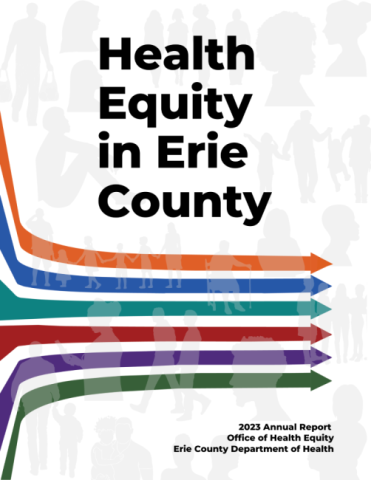The Erie County Department of Health’s (ECDOH) Office of Health Equity (ECOHE) has released its 2023 Annual Report, which highlights the office’s initiatives and documents the results of its community survey and focus groups.
ECOHE was established by the Erie County Health Equity Act of 2021, a law that also included direction to publish annual reports on ECOHE achievements, data on populations served by ECOHE’s outreach, and goals. The 2023 Annual Report provides a comprehensive summary of ECOHE’s programs around Mental Health First Aid Training, Children and Youth with Special Health Care Needs, a Grants Program and Technical Assistance, and Newsletter series. Other projects around Hispanic/Latino Community Programming, Communications and Language Access, a Holistic Healing Pilot Program, Mindfulness and Breastfeeding/Chestfeeding/Lactation-friendly Worksites were also featured.
Central to the report is the Community Wellness Survey, which collected information through traditional survey methods and focus groups. Those methods build on and supplement existing health equity data presented in 2023 report, Health Equity in Erie County: An Initial Health Disparities Assessment, and add new relevant, specific, and accurate local data describing the current health of Erie County residents. A series of discussions with community leaders is planned for later this year to further inform key findings.
“Moving forward, this report will inform local efforts to identify root causes of systemic issues and establish a deeper understanding of how people interact with systems that have a fundamental impact – positive or negative – on their health and quality of life,” said Commissioner of Health Dr. Gale Burstein.
“Data are a foundation on which we build policies and programs, so we need to get that right from the start. As our team evaluated and compiled data from a wide array of sources, we consistently found that data collection plays a key role in the process of addressing inequities,” said Office of Health Equity Director Kelly Wofford. “Existing data sources can have severe lags in reporting, and both explicit and implicit flaws in how data is collected, collated and compiled. Continued data collection gives our office, the County and other interested organizations a clearer and more comprehensive view of past circumstances, current conditions and future trends.”
The report goes beyond a simple presentation of survey responses. Six sections, each structured around a social determinant of health (SDOH), offer detailed visualizations of Erie County residents’ experiences around economic stability, neighborhood and built environment; health care system; education, social and community context; and, language access. Charts and graphs are interspersed with comments and remarks from focus group participants, adding both emotions and personal experiences to emphasize the content.
Key findings included:
- Race and Ethnicity Correlate to Assets and Advantages. There are stark differences in rates of assets and advantages, such as homeownership and use of a personal vehicle, among Erie County residents based on race and ethnicity, even when controlling for education level in many instances.
- Racially and ethnically minoritized respondents reported poorer finances and fewer assets than non-Hispanic White respondents with the same level of formal education.
- Respondents who reported their race and ethnicity as non-Hispanic White were far more likely than any other racial or ethnic group to report that they own their homes or report that they get around by personal vehicle.
- Having fewer assets and advantages also correlated to more challenges and barriers related to other SDOH factors, such as finding or keeping a job, accessing food and other life necessities, and having enough money to pay for day-to-day expenses.
- Accessing Quality Health Care Is a Challenge for Marginalized Groups. When examined by race, ethnicity, gender, and sexual orientation, access to care and quality of health care among Erie County residents were consistently lower for minority groups.
- Barriers Include Affordability, Education Level, Transportation, and Language Access
- Affordability was a prominent challenge across SDOH domains, and was reported as a barrier to accessing transportation, eating healthy, and obtaining child care and adult care across all demographic groups.
- Formal education level was reported as a barrier to employment for many Erie County residents. Higher levels of formal education were clearly associated with increased assets and stability, including respondents' housing and financial situations.
- Public transportation barriers are also present in Erie County, and disproportionately impact urban and rural residents.
- Survey and focus group data also indicate that language access is a barrier to health care access in Erie County for those whose primary language is not English.
ECOHE will present the community survey results at a July 17 webinar: Register here.
#
Erie County Department of Health (ECDOH), Office of Health Equity: http://www.erie.gov/health-equity
ECDOH Office of Health Equity, Reports: https://www3.erie.gov/health/health-equity-reports
###
